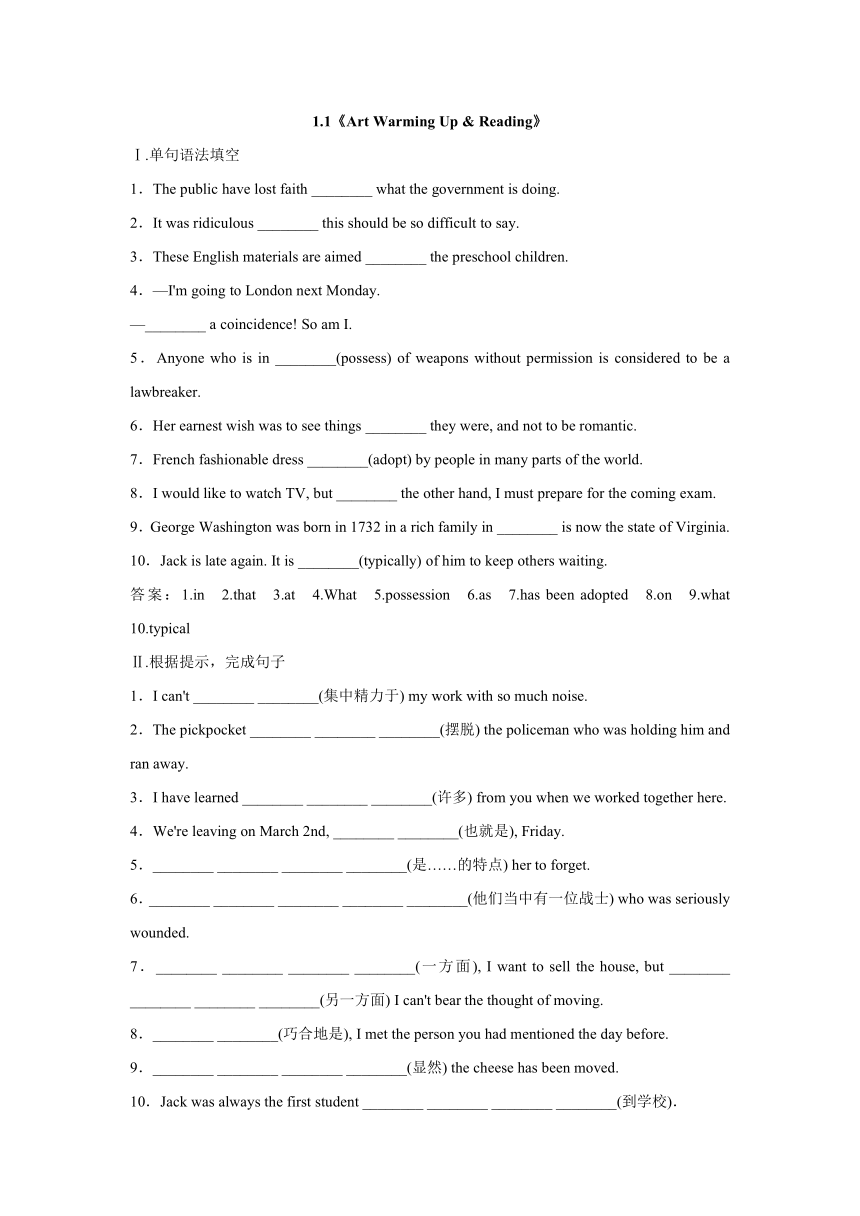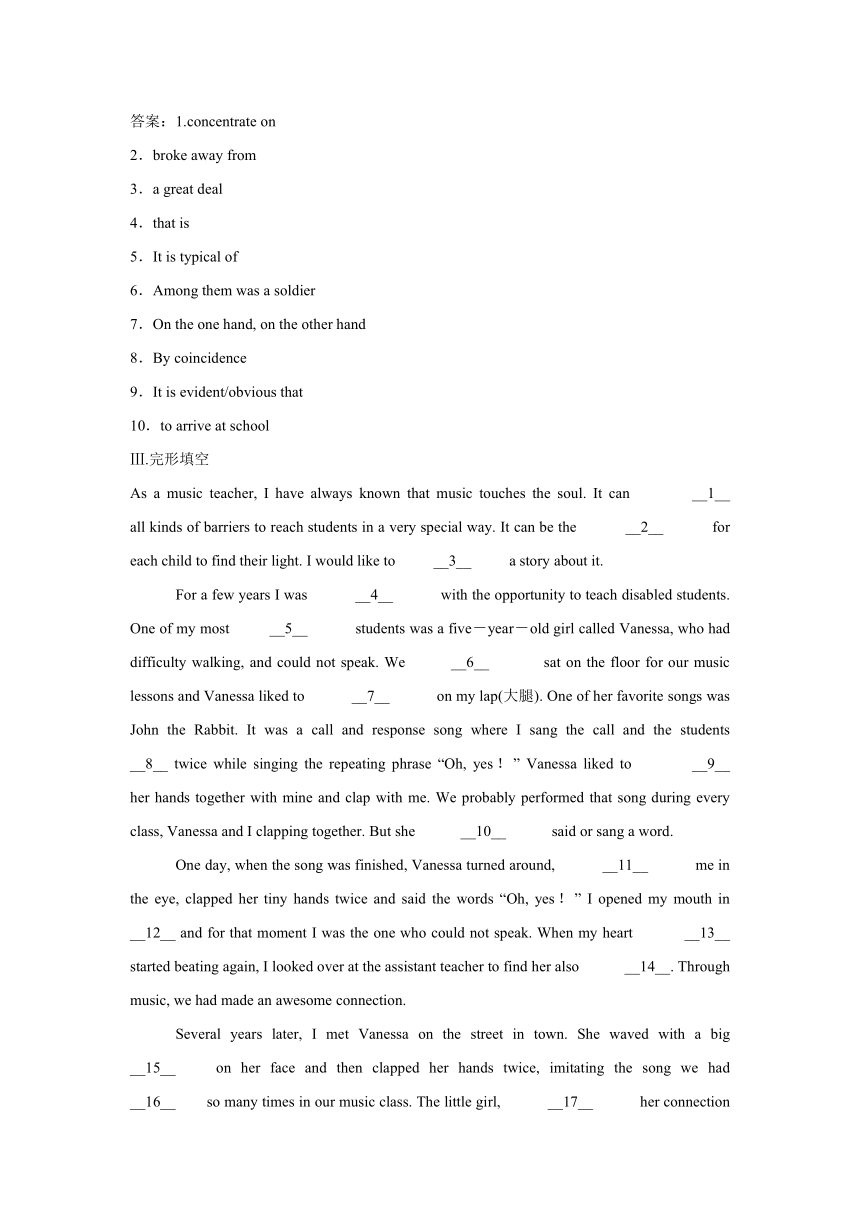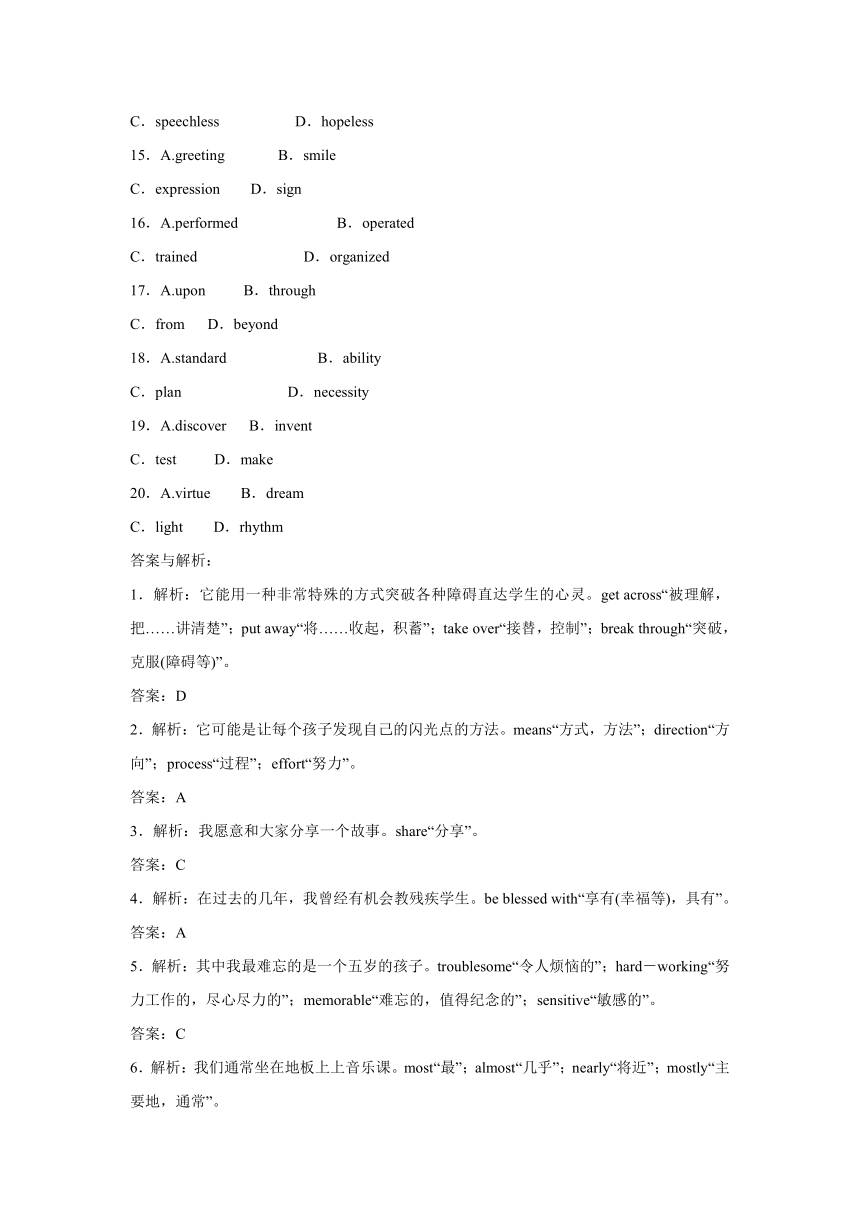2015-2016学年高中英语 1.1《Art Warming Up & Reading》练习(含部分答案解析)
文档属性
| 名称 | 2015-2016学年高中英语 1.1《Art Warming Up & Reading》练习(含部分答案解析) |  | |
| 格式 | zip | ||
| 文件大小 | 16.7KB | ||
| 资源类型 | 教案 | ||
| 版本资源 | 人教版(新课程标准) | ||
| 科目 | 英语 | ||
| 更新时间 | 2016-04-20 14:33:23 | ||
图片预览




文档简介
1.1《Art Warming Up & Reading》
Ⅰ.单句语法填空
1.The public have lost faith ________ what the government is doing.
2.It was ridiculous ________ this should be so difficult to say.
3.These English materials are aimed ________ the preschool children.
4.—I'm going to London next Monday.
—________ a coincidence! So am I.
5.Anyone who is in ________(possess) of weapons without permission is considered to be a lawbreaker.
6.Her earnest wish was to see things ________ they were, and not to be romantic.
7.French fashionable dress ________(adopt) by people in many parts of the world.
8.I would like to watch TV, but ________ the other hand, I must prepare for the coming exam.
9.George Washington was born in 1732 in a rich family in ________ is now the state of Virginia.
10.Jack is late again. It is ________(typically) of him to keep others waiting.
答案:1.in 2.that 3.at 4.What 5.possession 6.as 7.has been adopted 8.on 9.what 10.typical
Ⅱ.根据提示,完成句子
1.I can't ________ ________(集中精力于) my work with so much noise.
2.The pickpocket ________ ________ ________(摆脱) the policeman who was holding him and ran away.
3.I have learned ________ ________ ________(许多) from you when we worked together here.
4.We're leaving on March 2nd, ________ ________(也就是), Friday.
5.________ ________ ________ ________(是……的特点) her to forget.
6.________ ________ ________ ________ ________(他们当中有一位战士) who was seriously wounded.
7.________ ________ ________ ________(一方面), I want to sell the house, but ________ ________ ________ ________(另一方面) I can't bear the thought of moving.
8.________ ________(巧合地是), I met the person you had mentioned the day before.
9.________ ________ ________ ________(显然) the cheese has been moved.
10.Jack was always the first student ________ ________ ________ ________(到学校).
答案:1.concentrate on
2.broke away from
3.a great deal
4.that is
5.It is typical of
6.Among them was a soldier
7.On the one hand, on the other hand
8.By coincidence
9.It is evident/obvious that
10.to arrive at school
Ⅲ.完形填空
As a music teacher, I have always known that music touches the soul. It can __1__ all kinds of barriers to reach students in a very special way. It can be the __2__ for each child to find their light. I would like to __3__ a story about it.
For a few years I was __4__ with the opportunity to teach disabled students. One of my most __5__ students was a five-year-old girl called Vanessa, who had difficulty walking, and could not speak. We __6__ sat on the floor for our music lessons and Vanessa liked to __7__ on my lap(大腿). One of her favorite songs was John the Rabbit. It was a call and response song where I sang the call and the students __8__ twice while singing the repeating phrase “Oh, yes!” Vanessa liked to __9__ her hands together with mine and clap with me. We probably performed that song during every class, Vanessa and I clapping together. But she __10__ said or sang a word.
One day, when the song was finished, Vanessa turned around, __11__ me in the eye, clapped her tiny hands twice and said the words “Oh, yes!” I opened my mouth in __12__ and for that moment I was the one who could not speak. When my heart __13__ started beating again, I looked over at the assistant teacher to find her also __14__. Through music, we had made an awesome connection.
Several years later, I met Vanessa on the street in town. She waved with a big __15__ on her face and then clapped her hands twice, imitating the song we had __16__ so many times in our music class. The little girl, __17__ her connection with music, left an impression on me that will last forever. Every child has the __18__ to learn and grow. It is up to us to __19__ the way to reach each and every one of our students. We all must find each child's __20__.
1.A.get across B.put away
C.take over D.break through
2.A.means B.direction
C.process D.effort
3.A.add B.talk
C.share D.write
4.A.blessed B.tired
C.covered D.filled
5.A.troublesome B.hard-working
C.memorable D.sensitive
6.A.most B.almost
C.nearly D.mostly
7.A.stand B.sit
C.lie D.jump
8.A.sang B.said
C.followed D.clapped
9.A.strike B.put
C.give D.shake
10.A.ever B.never
C.still D.even
11.A.looked B.saw
C.found D.noticed
12.A.horror B.delight
C.astonishment D.embarrassment
13.A.immediately B.fortunately
C.slowly D.finally
14.A.happy B.grateful
C.speechless D.hopeless
15.A.greeting B.smile
C.expression D.sign
16.A.performed B.operated
C.trained D.organized
17.A.upon B.through
C.from D.beyond
18.A.standard B.ability
C.plan D.necessity
19.A.discover B.invent
C.test D.make
20.A.virtue B.dream
C.light D.rhythm
答案与解析:
1.解析:它能用一种非常特殊的方式突破各种障碍直达学生的心灵。get across“被理解,把……讲清楚”;put away“将……收起,积蓄”;take over“接替,控制”;break through“突破,克服(障碍等)”。
答案:D
2.解析:它可能是让每个孩子发现自己的闪光点的方法。means“方式,方法”;direction“方向”;process“过程”;effort“努力”。
答案:A
3.解析:我愿意和大家分享一个故事。share“分享”。
答案:C
4.解析:在过去的几年,我曾经有机会教残疾学生。be blessed with“享有(幸福等),具有”。
答案:A
5.解析:其中我最难忘的是一个五岁的孩子。troublesome“令人烦恼的”;hard-working“努力工作的,尽心尽力的”;memorable“难忘的,值得纪念的”;sensitive“敏感的”。
答案:C
6.解析:我们通常坐在地板上上音乐课。most“最”;almost“几乎”;nearly“将近”;mostly“主要地,通常”。
答案:D
7.解析:联系上文who had difficulty walking可知这个小女孩是坐在我的大腿上的。
答案:B
8.解析:从下文clap with me可知答案,clap意为“拍手”。
答案:D
9.解析:Vanessa喜欢把她的手和我的手放在一起,然后和我一起拍手。strike“敲击”;put“放”;give“给”;shake“摇动”。
答案:B
10.解析:因为不会说话,所以她从来不说也不唱一个字。
答案:B
11.解析:Vanessa转过身,直视着我的眼睛。look sb.in the eye“直视某人的眼睛”。
答案:A
12.解析: 看到不会说话的小女孩突然张嘴说话了,我非常吃惊地张大了嘴。horror“恐惧”;delight“高兴”;astonishment“惊讶”;embarrassment“尴尬”。
答案:C
13.解析:因吃惊忘了呼吸,忘了心跳,但最终还是回过神来了,所以用finally。
答案:D
14.解析:我看着那个助理教师,发现她也惊讶地说不出话来了。speechless“无语的”。
答案:C
15.解析:她脸上挂着微笑,向我招手。
答案:B
16.解析:模仿我们在音乐课上表演了很多次的那首歌。perform“表演”;operate“操作”;train“训练”;organize“组织”。
答案:A
17.解析:through“通过”,表示方式。此处意为“通过她与音乐的联系。”
答案:B
18.解析: 每个孩子都有学习和成长的能力。
答案:B
19.解析:得靠我们去发现通往每个学生心灵的道路。discover“发现”;invent“发明”;test“检验”;make“做”。
答案:A
20.解析:我们都一定会找到每个孩子的闪光点,这句话和第一段中的It can be ...find their light.相照应。
答案:C
Ⅳ.阅读理解
No artist has affected modern art more than Pablo Picasso. The thousands of masterpieces he had created changed the way people thought about art. Picasso was perhaps the most talented and successful artist who ever lived.
Pablo Ruiz Picasso was born in 1881 in a small town on the southern coast of Spain. His father was a painter who taught art. Picasso showed exceptional talent at an early age and,by the time he was in his teens,painted better than his father or any of the local art teachers. At sixteen, Picasso was sent to the Royal Academy of Madrid, where students drew from plaster casts and copied works of the old masters. Picasso felt these assignments were pointless and began to work on his own. Picasso's father soon became angry with his son's rebellious behavior, long hair, and strange clothes. He believed that Picasso was wasting his talent and scolded him, “Why don't you cut your hair and paint sensibly?”
In 1900,Picasso left for Paris — then the center of the art world. He lived in a cold,rundown building, painting constantly, sometimes surviving for days on only a piece of bread. During these years, his art reflected his dismal(凄凉的) surroundings. Homeless outcasts were the subject of many of his fairly realistic early paintings. After seeing African masks and sculptures,his works became more simplified and angular(有角的) leading up to the revolutionary new style known as Cubism(立体主义).
Picasso didn't sell many of his works during these early years. On May 8,1995, Picasso's Angel Fernanadez de Soto was sold at auction for $29 million. The next day Blue Period, one of his later works,sold for $5 million. But he worked continuously, always experimenting with different styles of painting. Though Picasso lived to be ninety-two and became the most famous artist in the world, he spoke of his youthful days in Paris as “the happiest time of my life”.
??1.This passage mainly discusses ________.
A.Picasso's Cubism as a revolutionary style in art
B.Picasso as a rebel and his art
C.Picasso's life and painting in Paris
D.Picasso's influences on the development of modern
art
2.Pablo Picasso showed unusual talent for painting
________.
A.in his early childhood
B.in his early teens
C.at the age of sixteen
D.when he painted better than local art teachers
3.Pablo Picasso started to reveal his rebellious spirit ________.
A.when he was a child
B.in his early teens
C.when he was studying in the Royal Academy
D.after he moved to Paris
4.What marks something of a turning point in his career as an artist
A.Those miserable but fruitful youthful days in Paris.
B.Those realistic paintings reflecting dismal social surroundings.
C.The influence of masks and sculptures created by native African artists.
D.Experimenting with new different styles of painting.
答案与解析:
1.解析:主旨大意题。通读全文可知,本文主要讲述了有逆反心理的毕加索的生平事迹和画作,故选B项。
答案:B
2.解析:细节理解题。由第二段第三句可知,毕加索早在很小的时候就展现出了他的绘画天赋而且到十几岁时就比他父亲画得好了。
答案:A
3.解析:细节理解题。由第二段第四、五、六句可知,毕加索是在皇家学院学习时开始表现出叛逆的一面的。
答案:C
4.解析:细节理解题。由第三段末句可知,毕加索在事业上的转折点是受到了非洲土著人创作的面具和雕塑的影响。
答案:C
Ⅰ.单句语法填空
1.The public have lost faith ________ what the government is doing.
2.It was ridiculous ________ this should be so difficult to say.
3.These English materials are aimed ________ the preschool children.
4.—I'm going to London next Monday.
—________ a coincidence! So am I.
5.Anyone who is in ________(possess) of weapons without permission is considered to be a lawbreaker.
6.Her earnest wish was to see things ________ they were, and not to be romantic.
7.French fashionable dress ________(adopt) by people in many parts of the world.
8.I would like to watch TV, but ________ the other hand, I must prepare for the coming exam.
9.George Washington was born in 1732 in a rich family in ________ is now the state of Virginia.
10.Jack is late again. It is ________(typically) of him to keep others waiting.
答案:1.in 2.that 3.at 4.What 5.possession 6.as 7.has been adopted 8.on 9.what 10.typical
Ⅱ.根据提示,完成句子
1.I can't ________ ________(集中精力于) my work with so much noise.
2.The pickpocket ________ ________ ________(摆脱) the policeman who was holding him and ran away.
3.I have learned ________ ________ ________(许多) from you when we worked together here.
4.We're leaving on March 2nd, ________ ________(也就是), Friday.
5.________ ________ ________ ________(是……的特点) her to forget.
6.________ ________ ________ ________ ________(他们当中有一位战士) who was seriously wounded.
7.________ ________ ________ ________(一方面), I want to sell the house, but ________ ________ ________ ________(另一方面) I can't bear the thought of moving.
8.________ ________(巧合地是), I met the person you had mentioned the day before.
9.________ ________ ________ ________(显然) the cheese has been moved.
10.Jack was always the first student ________ ________ ________ ________(到学校).
答案:1.concentrate on
2.broke away from
3.a great deal
4.that is
5.It is typical of
6.Among them was a soldier
7.On the one hand, on the other hand
8.By coincidence
9.It is evident/obvious that
10.to arrive at school
Ⅲ.完形填空
As a music teacher, I have always known that music touches the soul. It can __1__ all kinds of barriers to reach students in a very special way. It can be the __2__ for each child to find their light. I would like to __3__ a story about it.
For a few years I was __4__ with the opportunity to teach disabled students. One of my most __5__ students was a five-year-old girl called Vanessa, who had difficulty walking, and could not speak. We __6__ sat on the floor for our music lessons and Vanessa liked to __7__ on my lap(大腿). One of her favorite songs was John the Rabbit. It was a call and response song where I sang the call and the students __8__ twice while singing the repeating phrase “Oh, yes!” Vanessa liked to __9__ her hands together with mine and clap with me. We probably performed that song during every class, Vanessa and I clapping together. But she __10__ said or sang a word.
One day, when the song was finished, Vanessa turned around, __11__ me in the eye, clapped her tiny hands twice and said the words “Oh, yes!” I opened my mouth in __12__ and for that moment I was the one who could not speak. When my heart __13__ started beating again, I looked over at the assistant teacher to find her also __14__. Through music, we had made an awesome connection.
Several years later, I met Vanessa on the street in town. She waved with a big __15__ on her face and then clapped her hands twice, imitating the song we had __16__ so many times in our music class. The little girl, __17__ her connection with music, left an impression on me that will last forever. Every child has the __18__ to learn and grow. It is up to us to __19__ the way to reach each and every one of our students. We all must find each child's __20__.
1.A.get across B.put away
C.take over D.break through
2.A.means B.direction
C.process D.effort
3.A.add B.talk
C.share D.write
4.A.blessed B.tired
C.covered D.filled
5.A.troublesome B.hard-working
C.memorable D.sensitive
6.A.most B.almost
C.nearly D.mostly
7.A.stand B.sit
C.lie D.jump
8.A.sang B.said
C.followed D.clapped
9.A.strike B.put
C.give D.shake
10.A.ever B.never
C.still D.even
11.A.looked B.saw
C.found D.noticed
12.A.horror B.delight
C.astonishment D.embarrassment
13.A.immediately B.fortunately
C.slowly D.finally
14.A.happy B.grateful
C.speechless D.hopeless
15.A.greeting B.smile
C.expression D.sign
16.A.performed B.operated
C.trained D.organized
17.A.upon B.through
C.from D.beyond
18.A.standard B.ability
C.plan D.necessity
19.A.discover B.invent
C.test D.make
20.A.virtue B.dream
C.light D.rhythm
答案与解析:
1.解析:它能用一种非常特殊的方式突破各种障碍直达学生的心灵。get across“被理解,把……讲清楚”;put away“将……收起,积蓄”;take over“接替,控制”;break through“突破,克服(障碍等)”。
答案:D
2.解析:它可能是让每个孩子发现自己的闪光点的方法。means“方式,方法”;direction“方向”;process“过程”;effort“努力”。
答案:A
3.解析:我愿意和大家分享一个故事。share“分享”。
答案:C
4.解析:在过去的几年,我曾经有机会教残疾学生。be blessed with“享有(幸福等),具有”。
答案:A
5.解析:其中我最难忘的是一个五岁的孩子。troublesome“令人烦恼的”;hard-working“努力工作的,尽心尽力的”;memorable“难忘的,值得纪念的”;sensitive“敏感的”。
答案:C
6.解析:我们通常坐在地板上上音乐课。most“最”;almost“几乎”;nearly“将近”;mostly“主要地,通常”。
答案:D
7.解析:联系上文who had difficulty walking可知这个小女孩是坐在我的大腿上的。
答案:B
8.解析:从下文clap with me可知答案,clap意为“拍手”。
答案:D
9.解析:Vanessa喜欢把她的手和我的手放在一起,然后和我一起拍手。strike“敲击”;put“放”;give“给”;shake“摇动”。
答案:B
10.解析:因为不会说话,所以她从来不说也不唱一个字。
答案:B
11.解析:Vanessa转过身,直视着我的眼睛。look sb.in the eye“直视某人的眼睛”。
答案:A
12.解析: 看到不会说话的小女孩突然张嘴说话了,我非常吃惊地张大了嘴。horror“恐惧”;delight“高兴”;astonishment“惊讶”;embarrassment“尴尬”。
答案:C
13.解析:因吃惊忘了呼吸,忘了心跳,但最终还是回过神来了,所以用finally。
答案:D
14.解析:我看着那个助理教师,发现她也惊讶地说不出话来了。speechless“无语的”。
答案:C
15.解析:她脸上挂着微笑,向我招手。
答案:B
16.解析:模仿我们在音乐课上表演了很多次的那首歌。perform“表演”;operate“操作”;train“训练”;organize“组织”。
答案:A
17.解析:through“通过”,表示方式。此处意为“通过她与音乐的联系。”
答案:B
18.解析: 每个孩子都有学习和成长的能力。
答案:B
19.解析:得靠我们去发现通往每个学生心灵的道路。discover“发现”;invent“发明”;test“检验”;make“做”。
答案:A
20.解析:我们都一定会找到每个孩子的闪光点,这句话和第一段中的It can be ...find their light.相照应。
答案:C
Ⅳ.阅读理解
No artist has affected modern art more than Pablo Picasso. The thousands of masterpieces he had created changed the way people thought about art. Picasso was perhaps the most talented and successful artist who ever lived.
Pablo Ruiz Picasso was born in 1881 in a small town on the southern coast of Spain. His father was a painter who taught art. Picasso showed exceptional talent at an early age and,by the time he was in his teens,painted better than his father or any of the local art teachers. At sixteen, Picasso was sent to the Royal Academy of Madrid, where students drew from plaster casts and copied works of the old masters. Picasso felt these assignments were pointless and began to work on his own. Picasso's father soon became angry with his son's rebellious behavior, long hair, and strange clothes. He believed that Picasso was wasting his talent and scolded him, “Why don't you cut your hair and paint sensibly?”
In 1900,Picasso left for Paris — then the center of the art world. He lived in a cold,rundown building, painting constantly, sometimes surviving for days on only a piece of bread. During these years, his art reflected his dismal(凄凉的) surroundings. Homeless outcasts were the subject of many of his fairly realistic early paintings. After seeing African masks and sculptures,his works became more simplified and angular(有角的) leading up to the revolutionary new style known as Cubism(立体主义).
Picasso didn't sell many of his works during these early years. On May 8,1995, Picasso's Angel Fernanadez de Soto was sold at auction for $29 million. The next day Blue Period, one of his later works,sold for $5 million. But he worked continuously, always experimenting with different styles of painting. Though Picasso lived to be ninety-two and became the most famous artist in the world, he spoke of his youthful days in Paris as “the happiest time of my life”.
??1.This passage mainly discusses ________.
A.Picasso's Cubism as a revolutionary style in art
B.Picasso as a rebel and his art
C.Picasso's life and painting in Paris
D.Picasso's influences on the development of modern
art
2.Pablo Picasso showed unusual talent for painting
________.
A.in his early childhood
B.in his early teens
C.at the age of sixteen
D.when he painted better than local art teachers
3.Pablo Picasso started to reveal his rebellious spirit ________.
A.when he was a child
B.in his early teens
C.when he was studying in the Royal Academy
D.after he moved to Paris
4.What marks something of a turning point in his career as an artist
A.Those miserable but fruitful youthful days in Paris.
B.Those realistic paintings reflecting dismal social surroundings.
C.The influence of masks and sculptures created by native African artists.
D.Experimenting with new different styles of painting.
答案与解析:
1.解析:主旨大意题。通读全文可知,本文主要讲述了有逆反心理的毕加索的生平事迹和画作,故选B项。
答案:B
2.解析:细节理解题。由第二段第三句可知,毕加索早在很小的时候就展现出了他的绘画天赋而且到十几岁时就比他父亲画得好了。
答案:A
3.解析:细节理解题。由第二段第四、五、六句可知,毕加索是在皇家学院学习时开始表现出叛逆的一面的。
答案:C
4.解析:细节理解题。由第三段末句可知,毕加索在事业上的转折点是受到了非洲土著人创作的面具和雕塑的影响。
答案:C
